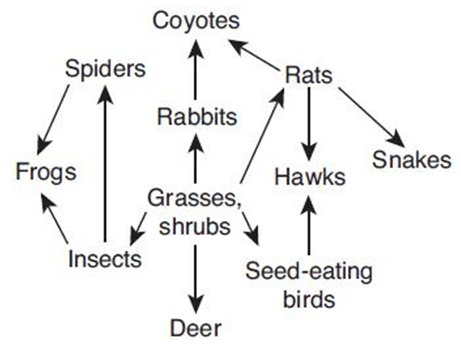All living factors in an ecosystem.
Biotic Factors
 What organism(s) represent the largest trophic level?
What organism(s) represent the largest trophic level?
Grasses, shrubs
What do the arrows in a food chain or food web represent?
Arrows represent how the energy is being transferred (who is eating who)
The atmosphere is comprised of ______% Nitrogen
78
All of the living things interacting with the nonliving aspects of the environment.
An ecosystem
In an energy pyramid, what is the proper name for ANY organism above the producer level?
Consumer
Name a predator-prey relationship
coyote - rabbit; spider - insect; hawks - seed eating birds
A gas produced by plants during photosynthesis that animals use for respiration. What is the gas and what cycle is it part of?
Oxygen; Carbon/Oxygen Cycle
A place where a plant or animal lives
Habitat
Only 10% of the energy available at each trophic level moves on to the next level. 90% is used by the organism or dissipated as _______________.
heat
What form of energy is in the food organisms consume?
Chemical Energy
______________ converts nitrogen into a useable form for plants and animals.
Bacteria
Interacting population of various kinds of individuals (as species) in a common location.
Community
What might happen if you remove a primary consumer from the ecosystem?
The number of plants would increase.

What might happen to the rabbit, insect, and seed-eating birds if grasses and shrubs were removed from the ecosystem?
The Herbivore populations would decrease.
Two ways nitrogen gas is turned into a form plants and animals can use are
lightning and bacteria
Rocks, Water, and Sunlight are examples of this type of factor.
Abiotic
Phytoplankton get their energy are _________________ and get their energy from ____________________.
producers; the sun
An organism that lives by breaking apart dead organic matter into simpler parts is
decomposer
The process by which waste and dead organisms release nitrogen back into the soil to be used again.
Denitrification